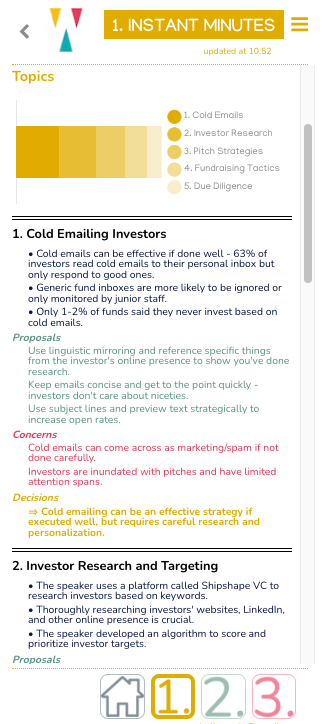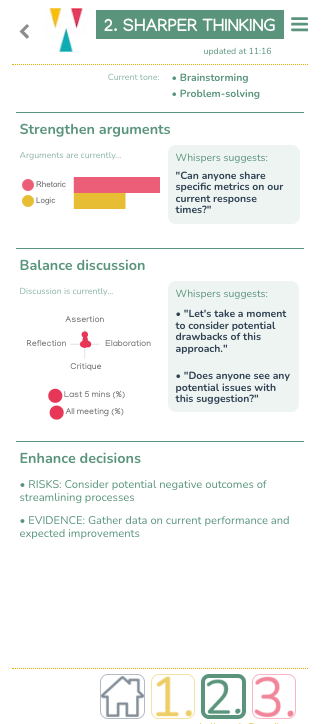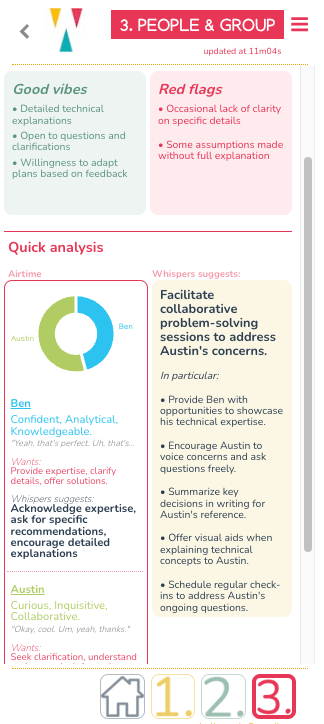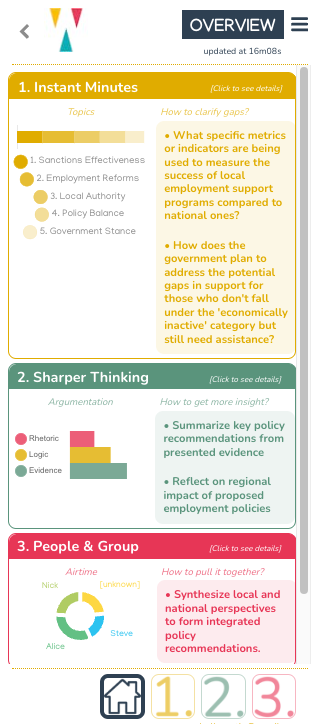The Science of Whispers
Whispers is special because it’s built on research and evidence.
Our foundations are multi-disciplinary: group dynamics, decision-making, and team performance.
Our design is shaped by insights from more than 100 books and research articles.
Here’s why Whispers is built the way it is:
1. Instant Minutes
--to capture and organise information
In a nutshell
Effective information sharing and integration is crucial for high-performing teams. But information is time-consuming and difficult to organise. And a lack of clarity and purpose are two main reasons why more than 50% of meetings are considered a waste of time.
So: Whispers captures and organises information automatically in a task-oriented format that is designed to facilitate clear thinking.
Science says… [click for details]
Surveys of meeting satisfaction usually indicate that a clear purpose and structure are some of the most important factors in meeting success. Clarity must be achieved during the meeting: it cannot be claimed only by sending minutes or meeting notes afterwards.
In a study of 92 teams from 20 different industries, teams that engaged in functional interactions, such as problem-solving and action planning, were correlated with meeting satisfaction. Those meetings were also correlated with higher team productivity.
Divergent information is more difficult to integrate into decisions when that information comes too late in a meeting. Actually, the people who speak most in the first 10 minutes of a meeting tend to have the most influence on decisions, regardless of the quality of their input. Often this is because the discussion is ‘anchored’ by the early expression of opinions and preferences.
And, tragically, knowledgeable people often hang back with important information, or assume that other people in the meeting already have it. There are social reasons for this too. When we’re in a meeting, we might be anxious or hesitant to voice an unpopular opinion. These patterns lead to biased decisions that don’t take advantage of the team’s full knowledge.
How Whispers delivers

Whispers gives you Instant Minutes that:
- Automatically capture and organize information shared during the meeting.
- Emphasise a diversity of views (proposals and concerns), and are oriented to task resolution (decisions).
- Suggest AI-augmented ideas for clarifications (information that is ambiguous or unclear) and follow-ups for the discussion.
- Are updated in real-time, so that you can spot gaps in the discussion.
Instant Minutes ensure that all relevant information is captured and considered, not just the loudest or earliest voices.
2. Sharper Thinking
—for discussions and decisions
In a nutshell
High-quality discussions and decisions depend on more than just information-sharing: they require information to be processed and debated wisely. If a deliberation process is biased, muzzled, or unduly forced to consensus, the resulting decisions and actions will be flawed or counterproductive.
So: Whispers flags imbalances and weaknesses in your discussion, and provides timely prompts and ideas to help address them.
Science says… [click for details]
A main reason that teams, companies and organisations exist, is to have access to a diversity of information, perspectives and skills. So it’s tragic that dissent is sometimes dealt with as a threat and a waste of time rather than an opportunity for mutual learning. Groups often fall prey to cognitive biases like groupthink, where the pressure for consensus overrides critical evaluation of alternatives. Prejudices and biases lead to premature decisions and, ultimately, wrong decisions.
Effective decision-making in groups usually requires:
- First, divergent thinking (gathering diverse ideas and perspectives)
- Then, convergent thinking (evaluating options and reaching consensus).
Meetings that incorporate diverse ideas tend to produce more robust decisions, by bringing a wider set of knowledge and skills to solve a problem. (Caveat: moderate diversity is more effective than extreme diversity where group members can’t find sufficient common ground or language to communicate with each other.)
The middle of this process is often uncomfortable (“the groan zone”), as people struggle to come to terms with a wide range of foreign or opposing ideas. But working through these incompatibilities and misunderstanding is what builds the foundation for sustainable decisions and agreements.
In the ‘Four Player Model’, four dialogic roles are identified: Movers, Followers, Opposers, and Bystanders. When only some of these roles are fulfilled, the dialogue won’t be so productive or wise. For example, critiquing proposals is important to anticipate and manage risks; and stepping back to reflect opens opportunities for lateral thinking.
Argumentation styles are important too. A discussion is lopsided if it’s all rhetoric with insufficient evidence; or if it presents a blizzard of data with insufficient logic to interpret the data. Statistically there is as an ‘optimum’ balance of argumentation styles that are most likely to convince a listener, though this optimum mix will vary between individuals.
Across various studies, the most consistently important determinant of good meetings is having clear goals on what the meeting should accomplish. A meeting agenda is only a partial solution: goals are not always shared across meeting participants, and require discussion and alignment where they differ. A constructive way to integrate differences is to interpret them as risks for each other’s goals, then collaborate to address them collectively.
In summary there are five key ingredients for high-quality decisions:
- diverse Ideas;
- mutual Understanding;
- relevant Evidence;
- clear Goals;
- transparent Risks.
If it helps to have an anagram: I-URGE.
(Or TIGER if ‘Understanding’ becomes ‘Triangulation’.)


How Whispers delivers


Whispers supports wiser decision-making by:
- Listening for the five key elements of high-quality decisions: Ideas; Understanding; Risks; Goals; and Evidence.
- Identifying the shape of discussion (assertions, elaborations, critiques, and reflections) and argumentation style (visualised as a graph of rhetorical, logical, and evidence-based statements).
- Proactively suggesting alternative viewpoints, to assist in ‘red-teaming’ or stress testing important judgements.
In future we hope to:
- Detect different phases of discussion (e.g. divergent, convergent, and ‘groan zone’), with appropriate interventions.
Sharper Thinking gives you insight for high-quality discussions and decisions.
3. Group Cohesion
—for engagement and collaboration
In a nutshell
Strong group cohesion leads to better collaboration, higher morale, and more effective meetings.
And after the meeting, “people support what they help to create.”
But group cohesion doesn’t come naturally: it depends on understanding values and beliefs, it requires active interventions by a meeting leader, and it can be quickly destroyed by individuals motivated by their own needs.
So: Whispers diagnoses the extent to which discussions are constructive, analyses speaker participation and personalities, and provides tips on increasing engagement and collaboration.
Science says… [click for details]
Groups with collective intelligence perform better across a wide range of tasks. You can think of collective intelligence like a ‘group IQ’. But collective intelligence is only weakly connected with individual intelligence. In a landmark experiment with several hundred teams, it turned out that only 15% of good decisions were determined by the average intelligence of team members. Instead, fully 40% of decision quality was dependent on the way that individuals interacted with each other.
The most important factors for generating ‘collective intelligence’ were:
- a more equal distribution of turn-taking in conversation;
- the average social perceptiveness of group members—i.e. the ability of team members to infer and assess each other’s state of mind;
- a higher proportion of women in the group (though being female may be partly endogenous with social perceptiveness).
Other studies have similarly found find teams with higher emotional intelligence tend to perform better. Far from being ‘soft’, these factors are critical to team success.
But reading and responding to social signals isn’t always easy. Many of us prioritize information and efficiency, and downgrade emotional needs. Reading social cues is especially difficult for neurodiverse professionals, who comprise one in every seven workers. And online meetings obscure our senses: 55% of people say social signals are more difficult to detect in videoconferences than in physical meetings.
When conflicts seem intractable, breakthroughs can often be achieved by moving beyond negotiations and arguments from ‘positions’. This paradigm is what facilitators call “below the surface”, because it aims to reveal the factors that generate demands and intransigence in order to engage them. It opens the possibility of an integrative, creative solution, rather than a distributive compromise. Or—to put it in negotiating language—a ‘win-win’.
In practice, getting ‘below the surface’ requires understanding everyone’s interests, values and beliefs. It builds on the evidence about collective intelligence, which shows that effective communication by any speaker in a group depends on understanding the states of mind of other people in that group.
Meetings must have an orientation to group outcomes, rather than being a forum only for the presentation of individual interests and agendas. Group orientation doesn’t come naturally, since individuals want to satisfy their own needs: to assert authority; to seek validation for their own views; to deflate the status of competitors; to gain attention for their past experiences or anecdotes; to use an audience opportunity to manipulate others. These behaviors have been typologized in various ways by various researchers, like Bales’ 12 observation categories and the Behaviour In Teams (BiT) and Act4Teams frameworks.
Recognising and attending to these behaviours is fundamental to the approach of professional meetings facilitators. Individual motivations can, in the right hands, be channelled productively towards group outcomes. In the words of an expert facilitator, “Everything that happens in the room is information for the facilitator to support the group.”
Meeting leaders can adopt some of these facilitative practices, to progress the group. Three studies of a total of 1,051 individuals in various industries found that the behaviour of leaders in a meeting determines between 7% and 70% of meeting satisfaction (Odermatt et al., 2017; Malouff et al., 2012; Baran et al., 2012). Effective behaviours for a leader include: explaining and following procedures, providing time to ask questions or share ideas, preventing monologues, paraphrasing attendee comments, and summarising decisions made at the end.
A positive mood in groups lead to more creative and integrative discussions. If at least one member of a team is cheerful and enthusiastic, this leads to improved cooperation, decreases conflict, and increases perceived task performance. Conversely, criticizing others and complaining have a measurably negative impact on productivity and effectiveness of meetings.
The idea of ‘psychological safety’ is proximate to this research on mood. ‘Psychological safety’ is the shared belief in a safe environment for interpersonal risk-taking, and is found to be crucial for team learning and performance. Psychological safety is usually created (or destroyed) by leaders who model and set the tone in a meeting. It can be increased by asking questions with compassion and curiosity (rather than challenge and interrogation), by listening carefully to responses, and by aiming to increase understanding rather than to resolve differences immediately.
How Whispers delivers


Our Group Cohesion functionality applies these findings by:
- Detecting collaborative vs confrontational group behaviours.
- Clearly showing the airtime of various speakers.
- Analyzing the styles, personalities, sentiments and desires of each meeting participant; and providing real-time guidance on managing emotions and conflict.
- Identifying ways to build psychological safety and increase engagement.
In future we hope to:
- Be more flexible to cultural factors.
(For example, to adjust Whispers’ output to cater for a greater comfort with frank exchanges in some countries, versus a culture of face-giving in others).
Group Cohesion gives you real-time feedback to foster a supportive environment, manage difficult situations and personalities, and enhance collaboration.
Overview
How Whispers delivers


An Overview screen brings the highlights from each of the diagnostic screens:
- Instant Minutes
- Sharper Thinking
- Group Cohesion
The ‘cognitive load’ during meetings is heavy. You need to process information, deliberate, and communicate, all at once.
Whispers provides you a selection of analyses that you can use flexibly in ways that suit you, depending on each team and each meeting.
Overview gives you a quick reference on information, deliberation, and communication.
Bringing Research into Practice
We’re committed to ongoing research and development.
This short summary is based on more than 100 books and research articles that inform the design of Whispers; but we want to stay at the cutting edge of evidence-based practice.
Please get in touch if you’d like to work with us to improve Whispers.
By bridging the gap between cutting-edge research and practical application, we aim to transform the way teams work together—in everyday meetings and interactions. We aim to make groups wise!
What else you'll notice
There are a growing number of meeting support tools: Otter, Fireflies, Read, and others. Whispers is different to almost all of them:
Most other meeting apps emphasise notes, summaries, and task allocation. But most meetings aren’t so mechanistic: they’re about debate, negotiation, egos, personalities, biases, and blindspots. Meeting success or failure depends on humans.
So Whispers gives these human factors the attention they deserve.
Whispers doesn’t send a ‘bot’ to join your meeting. There’s no annoying ‘helper’ or ‘assistant’ on your screen, and nobody needs to approve or reject.
Whispers sits quietly in the background, giving you information and analysis when you want it.
A growing number of tools give feedback on communication skills: pace, filler words, energy levels. Yet a healthy discussion isn’t a sequence of individual performances; it is a dynamic interaction for a group of people.
So Whispers focuses on group dynamics—about how people debate and collaborate—together.
Finally, why is Whispers designed to offer analysis privately rather than to the whole group? Because that’s what research suggests. Most people prefer private feedback rather than to be called-out publicly.